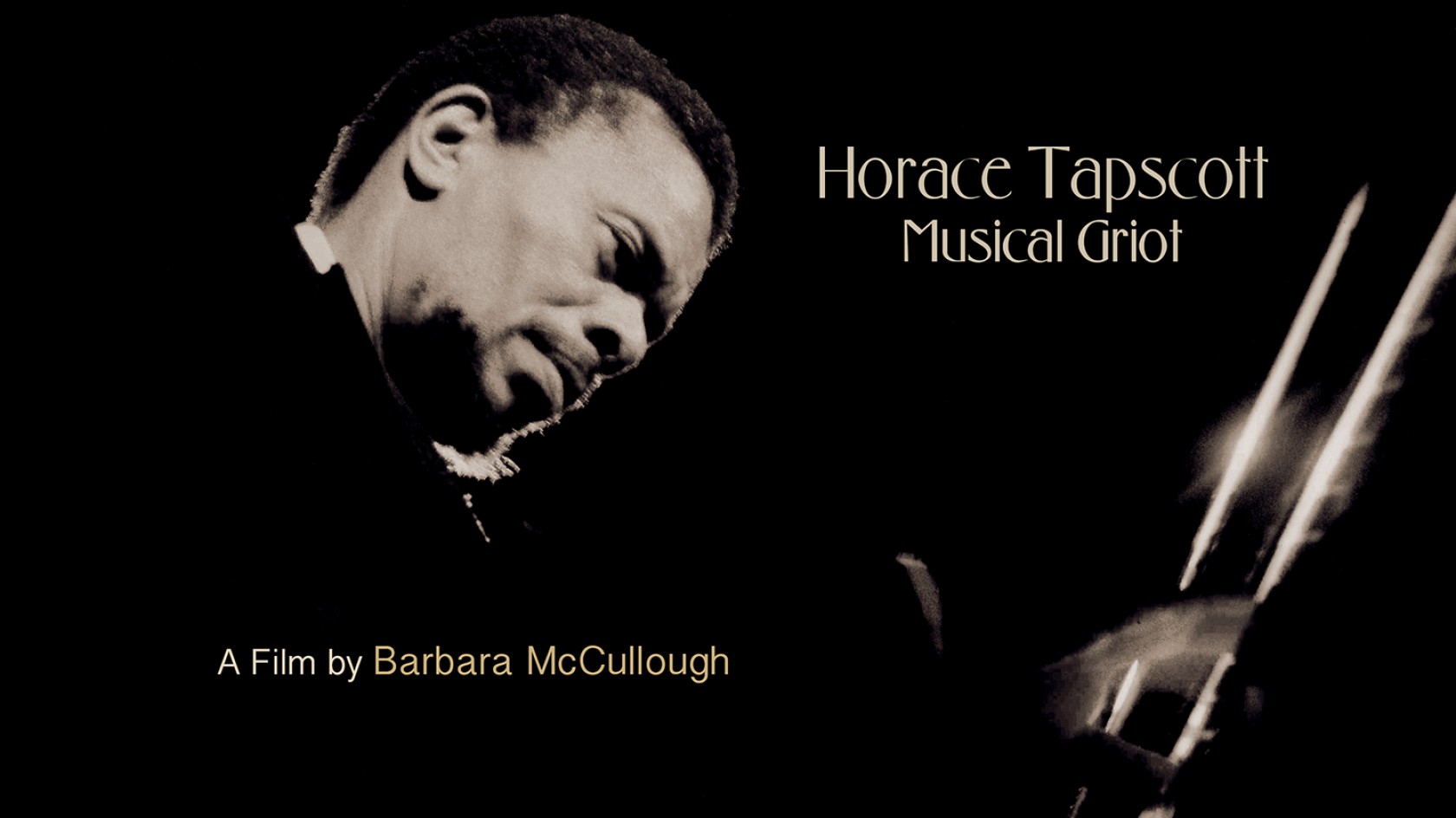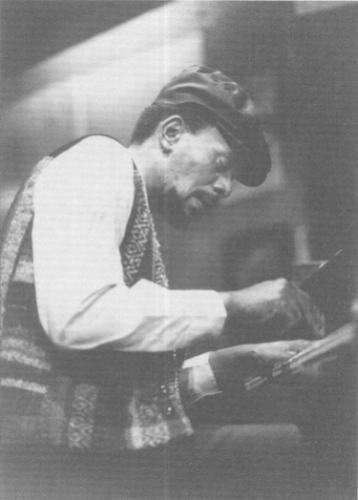SOUND PROJECTIONS
AN ONLINE QUARTERLY MUSIC MAGAZINE
EDITOR: KOFI NATAMBU
SUMMER, 2020
VOLUME NINE NUMBER ONE
BRIAN BLADE
Featuring the Musics and Aesthetic Visions of:
SULLIVAN FORTNER
(August 8-14)
JOEL ROSS
(August 15-21)
HORACE TAPSCOTT
(August 22-28)
BILLY HART
(August 29-September 4)
MARC CARY
(September 5-11)
EDDIE HENDERSON
(September 12-18)
CECIL MCBEE
(September 19-25)
MAKAYA MCCRAVEN
(September 26-October 2)
FRANK MORGAN
(October 3-9)
RASHIED ALI
(October 10-16)
DON REDMAN
(October 17-23)
IDRIS MUHAMMAD
(October 24-30)
https://www.allmusic.com/artist/horace-tapscott-mn0000219530/biography
Horace Tapscott
(1934-1999)
Artist Biography by Chris Kelsey
While Los Angeles is the power center of the popular music industry, it's always been a backwater as far as jazz is concerned. That's not because L.A. hasn't produced more than it's share of great players: a roll call of major players who made L.A. their home at some point would include Art Pepper, Dexter Gordon, Ornette Coleman, Gerry Mulligan, Chet Baker, and Charles Mingus, among many others. L.A.'s second-class status in the jazz world probably has more to do with the fact that it's about as geographically distant from the music's capitol -- New York City -- as is possible while still remaining on the same continent. Given the fact that, over the last several decades, New York critics have become probably the most provincial in jazzdom, it's little wonder that so many great California-based musicians are less critically vaunted than they might justifiably be. Simply put, being famous is not something a jazz musician from Los Angeles can count on. Horace Tapscott was the quintessence of the neglected Californian. Tapscott was a powerful, highly individual, bop-tinged pianist with avant-garde leanings; a legend and something of a father figure to latter generations of L.A.-based free jazz players, Tapscott labored mostly on the fringes of the critical mainstream, recording prolifically, but mostly for the small, poorly distributed Nimbus label. The quality of the music on those releases, however, was almost invariably high. His pianistic technique was hard and percussive, likened by some to that of Thelonious Monk and Herbie Nichols and every bit as distinctive. In contexts ranging from freely improvised duos to highly arranged big bands, Tapscott exhibited a solo and compositional voice that was his own.
Tapscott was born in Houston, TX, to a musical family. His mother, Mary Malone Tapscott, was a professional singer and pianist. At the age of nine, Tapscott moved with his family to Los Angeles. Tapscott reached maturity at a critical time in the history of L.A. jazz. The late '40s saw musicians the caliber of Dexter Gordon, Art Tatum, and Coleman Hawkins play the city's Central Avenue clubs with regularity; Charlie Parker also made the city home for a brief -- and infamous -- period. Saxophonist Buddy Collette and drummer Gerald Wilson were friends of the family. In his teens, Tapscott studied music with Dr. Samuel Brown and Lloyd Reese (students of the latter also included saxophonists Frank Morgan and Eric Dolphy). Tapscott studied trombone and piano. He graduated from Jefferson High School in 1952. He enlisted in the Air Force and played in a service band while stationed in Wyoming. After his discharge, Tapscott returned to Los Angeles, where he worked freelance. A stint as a trombonist with Lionel Hampton's big band took Tapscott to New York in 1959, where he was introduced by Eric Dolphy to John Coltrane. After a brief period in the city, Tapscott moved back to L.A. Around this time, Tapscott began concentrating on the piano. In the '60s, Tapscott became involved with the jazz avant-garde and community activism. In 1961, he helped found the Union of God's Musicians and Artists Ascension, which eventually spawned his Pan-African People's Arkestra. Both groups were designed to further the interests of creative young black jazz musicians. In 1968, Tapscott composed and arranged music for an acclaimed LP by the saxophonist Sonny Criss entitled The Birth of the New Cool. He had also begun leading a small group that included the soon-to-be-famous alto saxophonist Arthur Blythe. This band produced Tapscott's first album as a leader, The Giant Is Awakened, in 1969. Tapscott spent the next decade playing his own music and working in the community. His activism got him labeled as a troublemaker by many in the musical establishment. Paying gigs were scarce in the '70s, although Tapscott continued to create, performing at Parks and Recreation events and in churches around Watts. During this period, his only regular gig was at the Troubador on L.A.'s Restaurant Row. In 1977, Tapscott revived the dormant Pan-Afrikan People's Arkestra. The band became a multidisciplinary troupe, combining music with dance and poetry. The group came to the attention of producer Tom Albach, who began recording Tapscott for the Nimbus label. The long succession of albums to follow would become the basis of the pianist/composer's small but growing reputation. Albach also booked European tours for Tapscott, thus exposing his music worldwide. In 1979, Tapscott recorded with drummer Roy Haynes and bassist Art Taylor. In the '80s, Tapscott continued to flourish creatively as he continued to record for Nimbus (and in 1989, Hat Art) and perform both at home and abroad. In 1994, Tapscott took the entire Arkestra on a tour of Europe, with Blythe as a featured soloist. In the '90s, Tapscott had the opportunity -- long denied -- of recording for a well-distributed domestic label. Arabesque issued aiee! the Phantom, a quintet date that featured bassist Reggie Workman, drummer Andrew Cyrille, trumpeter Marcus Belgrave, and alto saxophonist Abraham Burton. Arabesque followed that with Thoughts of Dar-Es Salaam (1997), a trio set that included bassist Ray Drummond and drummer Billy Hart. At the time of his death in 1999 of lung cancer, it seemed that Tapscott's work was finally beginning to receive the attention it deserved.
 Horace Tapscott
Horace Tapscott
Born in 1934 in Houston, Texas, Horace came from a musical family centered around his mother, Mary Malone Tapscott, who worked professionally as a singer and pianist. When Horace was nine, the family moved to Los Angeles. As a teenager in the late 1940's, Horace was surrounded by the music of Central Avenue: Art Tatum, Charlie Parker, Coleman Hawkins, Dexter Gordon, were among the many cats on the set. Around this time, Horace also began to take music lessons from teachers Dr. Samuel R. Browne and Lloyd Reese, whose other students included Eric Dolphy and Frank Morgan. Horace's musical studies included trombone in addition to piano.
In 1952, Horace graduated from Jefferson High, got married to Cecilia Payne and went into the Air Force. Horace played in an Air Force Band while he was stationed in Wyoming for his term of duty. After mustering out, he returned to Los Angeles where he worked around on various gigs until he joined the Lionel Hampton Big Band as a trombonist.
In 1959, Horace finally went with the Hampton Big Band to New York, where his friend Eric Dolphy introduced him to John Coltrane. A tough winter, a lack of gigs, and too many nights on the floor of a friend's art gallery finally sent Horace packing for sunny Southern California, where a life with wife and family awaited his return.
The sixties saw Horace emerge as a die-hard leader of the Avant Garde. Horace began to gain public notice playing with his own group, that included alto saxophonist Arthur Blythe, bassist David Bryant, and drummer Everett Brown II. Horace also appeared on records for the first time (see discography).
Horace was always outspoken about racism, politics, stereotypes, and social ethics. His forward- minded vocal presence on and off the microphone is as much a part of his art as his piano playing. As a result, he was labeled a “dissident,” categorized as an “employment risk,” and black-listed from the music industry establishment in the early 1970's. None of this slowed Horace down. He began gigging sporadically at Parks and Recreation events and for churches around Watts. This “dark period,” with his only regular gig at his friend Doug Weston's Troubadour on Los Angeles' “Restaurant Row”, was also a time of intense creativity.
Around 1977, Horace reorganized the Pan-Afrikan Peoples Arkestra with the help of several old friends and many new faces. The Arkestra performances involve singing, dancing, and poetry in addition to the music. Soon after the new group's debut, Horace came to the attention of producer Tom Albach who contracted Horace to record a number of albums for Nimbus Records (see discography). Albach also helped introduce Horace to an international audience by arranging several European tours.
In 1979, another producer, Tosh Tanaki, took Horace to New York to record with legendary drummer Roy Haynes and bassist Dr. Art Davis (see discography). This was the beginning of a musical friendship that continued; Horace often played with Art's group at gigs around Los Angeles.
The 80's saw Horace emerge as one of jazz's premiere solo pianists. He recorded several solo piano albums for Nimbus (see discography). This phase culminated in the late 80's, with Horace sharing the bill at the Wilshire Ebell theatre with other jazz legends Andrew Hill and Randy Weston for a historic solo piano concert.
Horace kept extremely busy thru the 90's, composing new music, recording albums, and leading his group on tours of Europe and the United States--not to mention his perpetual involvement in the local community and his role as the patriarch of a large family. In 1994, Horace finally took the whole Arkestra to Europe. This tour was a huge success highlighted by the return of Arthur Blythe to the group as primary soloist.
https://www.allaboutjazz.com/the-dark-tree-horace-tapscott-hatology-review-by-troy-collins.php
Horace Tapscott: The Dark Tree
by
Play Horace Tapscott
on Amazon Music Unlimited (ad)
|
The Dark Tree is one of those revered dates, a live session recorded at the Catalina Bar & Grill in Hollywood in 1989. Originally released in two separate volumes by Hatology in 1991, it has been reissued as a two disc set, delivering on the promise of its reputation—invoking the spiritual ecstasy of New Thing era free jazz and loft scene era Black Nationalism—without sounding dated or histrionic.
A harmonically unfettered and unabashedly percussive pianist, Tapscott's angular themes and unusual time signatures are a natural outgrowth of the innovations of Thelonious Monk, Herbie Nichols, and early Cecil Taylor. Given free reign in this live setting, the all-star quartet of Tapscott, clarinetist John Carter, bassist Cecil McBee, and drummer Andrew Cyrille unleash a bracing combination of ecstatic free jazz, primal groove and opulent lyricism, lending credence to the date's legendary status.
The centerpiece of the record is the 21 minute title track, presented twice, with one take per disc. An ostinato fueled vamp of subterranean bass, menacing left hand piano refrains, and insistent snare accents, it features Carter's stratospheric clarinet cadences spiraling into oblivion, which set the stage for Tapscott and Cyrille's expansive ruminations. The leader's extended solo is a hallucinatory mosaic of ringing tones and hypnotic dissonances, with Cyrille's pneumatic variations building to a dramatic finish.
The remainder of the set exudes a similar energy, veering from the lilting 6/8 waltz of the carefree "Sketches Of Drunken Mary" to the crisp martial rhythms and labyrinthine bop interludes of "Lino's Pad." Carter sits out three of the five selections on the second volume, leaving ample room for Tapscott and his rhythm section to stretch out, especially on the epic "Nyja's Theme," a loose 3/4 vamp spotlighting Tapscott's kaleidoscopic variations, McBee's sinuous lyricism, and Cyrille's percussive invention.
A welcome reissue from a criminally under recognized composer, The Dark Tree is a stirring document, worthy of the attention of anyone interested in the full spectrum of jazz history.
Track Listing
CD1: The Dark Tree; Sketches Of Drunken Mary; Lino's Pad; One For Lately. CD2: Sandy And Niles; Bavarian Mist; The Dark Tree 2; A Dress For Renee; Nyja's Theme.Personnel
Horace Tapscott: piano; John Carter: clarinet; Cecil McBee: bass; Andrew Cyrille: drums.Album information
Title: The Dark Tree | Year Released: 2009 Record Label: Hat Hut Recordshttps://www.allaboutjazz.com/ancestral-echoes-the-covina-sessions-1976-horace-tapscott-with-the-pan-afrikan-peoples-arkestra-dark-tree-records
Horace Tapscott with the Pan Afrikan People’s Arkestra: Ancestral Echoes – The Covina Sessions, 1976
by
AllAboutJazz
AllAboutJazz
Play Horace Tapscott
on Amazon Music Unlimited (ad)
|
PAPA worked as a rotation of
musicians that often changed considerably from one project to another.
Of the twenty-four known participants on Ancestral Echoes, only
flutists Adele Sebastian and Aubrey Hart, and poet/percussionist Kamau
Daéood, were part of the live 1972-1981 compilation Live at I.C.U.U. (Soul Jazz Records, 2019).
Daéood, at Tapscott's request, had written the verse that accompanies
the pianist's nineteen-minute "Ancestral Echoes," a composition that
appeared in a much shorter version on Daéood's Leimert Park
(Mama Records, 1996). That album included Tapscott and his regular
bassist Roberto Miranda. Daéood's recitation gives way to an extended
Tapscott solo after two minutes, morphing into an orchestrated
masterwork with electrifying solos from trumpeter Steven Smith and
soprano saxophonist Jesse Sharps. Tapscott's quartet of Andrew Cyrille, Cecil McBee, and John Carter recorded "Sketches of Drunken Mary" on the seminal recording Dark Tree
(HatOLOGY, 1989), over twenty years after this version. Flutist Hart
and alto saxophonist Michael Session create a whirling back-and-forth
dialog bookended by Tapscott's expansive solos. At nearly a half-hour,
the closing track "Eternal Egypt Suite" features an ethereal Sebastian
flute in its opening segment, shifting to an Afro-Cuban theme, free
improvisation from tenor saxophonist Fuasi Abdul-Khaliq, and finally, a
lush, orchestral finish.
Tapscott's music, particularly with the Pan Afrikan People's Arkestra, is traditional in a way we rarely think of as tradition. The pianist/composer created and fostered multiple generations of Watts musicians through the nurturing of a sweeping philosophy of autonomous and organic creation with origins in Africa and South- Central LA. The reality Tapscott presents on Ancestral Echoes, plays out at the crossroad of music and values.
Track Listing
Ancestral Echoes; Sketches of Drunken Mary; Jo Annette; Eternal Egypt Suite.Personnel
Horace Tapscott: piano; Jesse Sharps: saxophone, soprano; Gary Bias: saxophone, alto; Michael Session: saxophone, alto; Fauci Abdul-Khaliq: saxophone, tenor; James Andrews: saxophone, tenor; Charles Sandler: saxophone, tenor; Amos Delone: saxophone, baritone; Steven Smith: trumpet; Lester Robertson: trombone; Wendell C. Williams: french horn; Red Callender: bass, acoustic; Linda Hill: piano; David Bryant: piano; Marcus McLaurine: bass; Ricky Simmons: drums; Ismael Balaka: drums; Moises Obligacion: congas; Kamau Da'ood: poet/spoken word; Herbert Callies: clarinet.Dadisi Komolafe: alto saxophone; Robert Watt: French horn.
Album information
Title: Ancestral Echoes – The Covina Sessions, 1976 | Year Released: 2020 | Record Label: Dark Tree Records
https://www.rollingstone.com/music/music-news/horace-tapscott-pan-afrikan-peoples-arkestra-live-841936/
Newly issued live recording from 1998 sheds light on a crucial L.A.
jazz figure who inspired Kamasi Washington and other future stars
This Horace Tapscott website began as a timeline recording Horace’s
performance history. It has expanded since then to include a section on
the music of the Arkestra, as well as a photo gallery. As research
continues, corrections and updating will continue, and, more material
will be provided. Queries and documented contributions are always
welcome.
The timeline records appearances, primarily musical, but not exclusively, by Horace Tapscott, and is a work-in-progress.
It has been compiled using public records, such as newspaper ads, articles, leaflets, etc., but most importantly the tape and ephemera collection in the Horace Tapscott Archive. Over the years, the diligent preservation work by the brothers and sisters of UGMA/UGMAA, resulted in tape recordings of hundreds of performances and rehearsals from 1960 to Horace’s passing on 27 February 1999. In 2002, with the assistance of Michael Dett Wilcots, UGMAA archivist and Horace’s son-in-law, I catalogued that collection, then housed in Horace’s garage/studio.
Until the early 1980s, recordings were made on reel-to-reel tapes. On many of those, the UGMA/UGMAA personnel responsible penned notes on the tape boxes, usually location, date, personnel, and compositions performed. Occasionally, other commentary was added. When relevant, these are included under the tag “Note”.
This collection provides the main source in documenting the musical history of the movement in those years, including such items as the various name changes the organization went through until finally settling on the Pan Afrikan Peoples Arkestra (PAPA) and the Union of God’s Musicians and Artists Ascension (UGMAA) in the early 1970s. While this information is invaluable, it is far from complete. Not all musicians and compositions are listed in some instances, but what information exists, is provided.
With the shift to cassette tapes in the early 1980s, much of the space for written commentary on the reel-to-reel boxes was lost, and consequently information on the cassettte tape containers is minimal or non-existent. While I listened to some to ascertain more information, it was not possible to go through the entire collection, which was donated shortly afterwards to the UCLA Music Library’s Special Collections.
The Horace Tapscott Archive also contains performances by other ensembles within the movement that did not include Horace’s participation. Since the focus of this list is Horace, those are not included, except in cases where they were part of a larger performance in which Horace participated. Some tapes with minimum information, such as “Arkestra,” are included since Horace’s participation is likely. Some rehearsals are also included, since tapes of them are extant in the Archive.
Another challenge is the sheer number of performances not recorded that Horace gave in his community, and how many of these were only advertised locally or not at all, particularly in the 1960s through the mid-1970s. Horace and UGMA/UGMAA were mainstays in various community settings, including parks, schools, and such venues as the Watts Happening Coffee House, and in the 1990s at 5th Street Dick’s Coffee Company in Leimert Park, but there is little documentation of the specifics.
As more information is uncovered, the Timeline will grow. Contributions via the comments section below are welcome, but must be documented in some fashion to gain a place in the Timeline.
It should be noted that this is not a cataloguing of biographical details, given the publication of Horace’s autobiography, Songs of the Unsung (2001). Also, a history of the movement can be found in my subsequent book, The Dark Tree (2006), which corrects factual errors in the autobiography, though much remains unknown. Historical detail was not Horace’s strong suit, but his passion, insight, values, ambitions, and artistry were.
Finally, in initiating this project, thanks are due to the support and contributions from poet and community activist Kamau Daáood, Bertrand Gastaut of Dark Tree Records (and his excellent Horace Tapscott blog), David Keller (Horace’s former manager), director/writer Jeannette Lindsay and writer / poet / publisher / perservationist / musician / radio host Mark Weber. This Timeline was also inspired by Mark’s exceptional work on his Bobby Bradford Timeline. The wonderful Klaus at Metropolis Free Jazz has made this an on-line reality. — Steven L. Isoardi
http://www.darktree-records.com/en/artistes/horace-tapscott-artiste
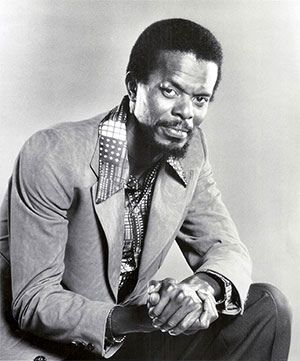
Tapscott, Horace Elva
(b. Houston, 6 April 1934; d Los Angeles, 27 February 1999). Pianist, composer, bandleader, and social activist. Began piano studies at six and trombone two years later. Moved with his family to Los Angeles in 1943, and was enveloped in the Central Avenue scene. Studied with Samuel Browne at Jefferson High School, where he played with alto saxophonist Frank Morgan. Private tutelage with Lloyd Reese followed, and mentoring by Gerald Wilson, Melba Liston, and composer William Grant Still. Friends included Don Cherry, Billy Higgins, and Larance Marable. Worked with Gerald Wilson’s orchestra before graduating from Jefferson in 1952. Enlisted in the air force in 1953, playing in the Ft. Warren band in Wyoming, until his discharge in 1957. Joined Lionel Hampton’s band in 1959, and toured until early 1961, at times sitting in on piano and arranging charts. By the early sixties piano had become Tapscott’s exclusive instrument, forced by persistent dental problems.
At the end of 1961 he formed the Underground Musicians Association (UGMA), ten years later evolving into the Union of God’s Musicians and Artists Ascension (UGMAA) with the Pan Afrikan Peoples Arkestra (PAPA) as one of its components. Over the years some three hundred artists were involved, including Arthur Blythe, Everett Brown, Jr., Kamau Daáood, Azar Lawrence, Roberto Miranda, Butch Morris, Wilber Morris, Sonship Theus, and Dwight Trible. Fusing art with social activism, the Arkestra developed and preserved black music and art within their community, performing on street corners, in parks, schools, churches, senior homes, social facilities and gathering spots, arts centers, and at political rallies. Although its activities tapered off by the early 1980s, the Arkestra continued performing into the 21stcentury.
Tapscott’s music ran the gamut, from free-form improvisation to folk songs and spirituals. The content, structure, and stylings of many pieces drew from the problems and routines of community life. He translated these into complex rhythmic patterns, crashing dissonances, and bittersweet melodies, using the entire range and even all the material elements (wood, strings, metal, ivories) of the piano. He composed for solo piano and small groups, the Arkestra and its choir, and even for symphony orchestra in his magnum opus, Ancestral Echoes. He was attracted to dark ostinati and a heavy bottom sound, as in “The Giant Is Awakened,” “The Dark Tree,” “Thoughts of Dar Es Salaam,” and “To the Great House.” Even when dealing with older material, such as Strayhorn’s “Lush Life,” or favored tunes from the bop era, like “Oleo” and “Now’s the Time,” Tapscott found a way to heavily root the compositions, while still exploring unique harmonic extensions.
During the 1960s Tapscott recorded with Onzy Matthews, Lou Blackburn, arranged and conducted two albums for singer and subsequent Black Panther Party leader Elaine Brown, composed and conducted the music for Sonny Criss’s Sonny’sDream (Birth of the New Cool)(1968, Prestige). His first album as leader appeared one year later,The Giant Is Awakened(Flying Dutchman), also Arthur Blythe’s recording debut. From 1978 through the mid 1980s he recorded for Interplay and Nimbus Records, labels formed by enthusiasts for Tapscott’s music. He led the Arkestra on three albums, recorded many solo albums (eleven issued to date), one duo with drummer Everett Brown, Jr., four trio discs, including the two-part live performance at the Lobero Theater in Santa Barbara, California, and one sextet album. Landmark recordings for hat ART (The Dark Tree) followed in 1989, and then two CDs for Arabesque in the 1990s. As of 2010, Nimbus West Records continues to release additional sessions and live performances.
• B. Ratliff: “Horace Tapscott: Staring No in the Face,”CODA,no. 242 (March/April 1992), 7-11
• H. Tapscott and S. Isoardi:Songs of the Unsung: The Musical and Social Journey of Horace Tapscott (Durham, NC: Duke University Press, 2001) [incl. discography]
• S. Isoardi: The Dark Tree: Jazz and the Community Arts in Los Angeles (Berkeley: University of California Press, 2006)
• D. Widener: Black Arts West: Culture and Struggle in Postwar Los Angeles (Durham: Duke University Press, 2010)
• S. Isoardi and M.D. Wilcots: Black Experience in the Fine Arts: An African American Community Arts Movement in a University Setting (Current Research in Jazz6, 2014, https://www.crj-online.org/v6/CRJ-BlackExperience.php)
Horace Tapscott Website
a work in progress:
https://horacetapscott.free-jazz.net
▶ HORACE TAPSCOTT with the PAN AFRIKAN PEOPLES ARKESTRA and the GREAT VOICE OF UGMAA WHY DON’T YOU LISTEN? – Live at LACMA, 1998 DT(RS)11
▶ HORACE TAPSCOTT with the PAN AFRIKAN PEOPLES ARKESTRA ANCESTRAL ECHOES – The Covina Sessions, 1976 DT(RS)13
https://www.kcet.org/shows/artbound/passing-the-magic-horace-tapscott-and-his-pan-afrikan-peoples-arkestra
Song You Need to Know: Horace Tapscott, ‘Why Don’t You Listen?’
Newly issued live recording from 1998 sheds light on a crucial L.A.
jazz figure who inspired Kamasi Washington and other future stars
by
Hank Shteamer
Unless you’re a hardcore jazz
aficionado, you might not know the name Horace Tapscott. But to several
generations of L.A. musicians — including breakout saxophone star Kamasi Washington — the late pianist and composer is a near-legendary figure.
“I grew up in Leimert Park and his footprint is all over that area,” Washington said in 2015
of Tapscott’s importance to his South L.A. neighborhood. “We all
learned his music and his philosophies from the elders who played with
him that are still with us. Horace is one of the most important figures
in the foundation of music in L.A., from both a purely musically and
socially conscious perspective. My dad took me to hear [Tapscott’s] Pan
Afrikan Peoples Arkestra many times and I played with them after Horace
passed away.”
If Washington’s sound — specifically the large-scale,
spirit lifting jazz meets gospel meets R&B documented on his 2015
breakthrough The Epic and its 2018 follow-up Heaven and Earth
— has a patron saint, it would have to be Tapscott. From the early
Sixties through his death in 1999, the pianist helped to anchor a
community-driven L.A. scene, bringing together musicians, singers and
poets in both the Arkestra (the name nods to a group led by Tapscott’s
like-minded predecessor Sun Ra) and an umbrella group called UGMAA, the Union of God’s Musicians and Artists Ascension.
A new archival release, Why Don’t You Listen?, captures the
ensemble that inspired Washington and his peers in the form of a 1998
Arkestra concert at the L.A. County Museum of Art, reportedly the final
time Tapscott was healthy enough to play piano with the band live.
Released by Dark Tree, a French label named for a Tapscott piece, it joins a wealth of other Tapscott and UGMAA work now available digitally.
Horace Tapscott with the Pan Afrikan Peoples Arkestra and the Great Voice of UGMAA Why Don't You Listen?
VIDEO: 14:21
VIDEO: 14:21
The album’s near-15-minute title track makes for a fine
introduction to Tapscott’s expansive approach. While much of the
Arkestra’s available output focuses on the leader’s intricate
instrumental writing, which ranges from funky to free, “Why Don’t You
Listen?” spotlights the voice. On the piece, co-written by Tapscott and
Linda Hill, a nine-member choir known as the Great Voice of UGMAA —
directed by Dwight Trible, who remains committed to Tapscott’s mission — sings out stirring variations on a central question: “Why didn’t you listen to the sounds of truth?”
After a brief, expressionistic piano intro, the vocalists
sing out a somber opening (“Go forth my seed / And spread the truth …”).
From there, the tempo picks up, and the singers begin calling out a
series of jazz icons — “Why didn’t you listen to Bird and Trane … ?/ Why
didn’t you listen to Lady Day?” — over an insistent pulse, complete
with hand percussion, booming brass and emphatic shouts. Around the
five-minute mark, the piece breaks into brisk post-bop swing, with the
soprano sax of Michael Session swooping over top. A solo vocal episode
and a slashing drum feature by Donald Dean lead back into the “Why
didn’t you listen …?” refrain.
The track’s blend of somber, gospel-like textures with
upbeat, unfettered improv does have precedents in jazz — Duke
Ellington’s Sacred Concerts, grand Charles Mingus works like “Meditations on Integration” — but Tapscott clearly developed his own rich aesthetic. Throughout Why Don’t You Listen?, it’s easy to hear why up-and-comers like Washington were so struck by his vision — and following that thread to Washington’s own work, equally plain to hear the echo of an earlier L.A. jazz revolution.
Introduction
A work-in-progress / compiled by Steven L. Isoardi
The timeline records appearances, primarily musical, but not exclusively, by Horace Tapscott, and is a work-in-progress.
It has been compiled using public records, such as newspaper ads, articles, leaflets, etc., but most importantly the tape and ephemera collection in the Horace Tapscott Archive. Over the years, the diligent preservation work by the brothers and sisters of UGMA/UGMAA, resulted in tape recordings of hundreds of performances and rehearsals from 1960 to Horace’s passing on 27 February 1999. In 2002, with the assistance of Michael Dett Wilcots, UGMAA archivist and Horace’s son-in-law, I catalogued that collection, then housed in Horace’s garage/studio.
Until the early 1980s, recordings were made on reel-to-reel tapes. On many of those, the UGMA/UGMAA personnel responsible penned notes on the tape boxes, usually location, date, personnel, and compositions performed. Occasionally, other commentary was added. When relevant, these are included under the tag “Note”.
This collection provides the main source in documenting the musical history of the movement in those years, including such items as the various name changes the organization went through until finally settling on the Pan Afrikan Peoples Arkestra (PAPA) and the Union of God’s Musicians and Artists Ascension (UGMAA) in the early 1970s. While this information is invaluable, it is far from complete. Not all musicians and compositions are listed in some instances, but what information exists, is provided.
With the shift to cassette tapes in the early 1980s, much of the space for written commentary on the reel-to-reel boxes was lost, and consequently information on the cassettte tape containers is minimal or non-existent. While I listened to some to ascertain more information, it was not possible to go through the entire collection, which was donated shortly afterwards to the UCLA Music Library’s Special Collections.
The Horace Tapscott Archive also contains performances by other ensembles within the movement that did not include Horace’s participation. Since the focus of this list is Horace, those are not included, except in cases where they were part of a larger performance in which Horace participated. Some tapes with minimum information, such as “Arkestra,” are included since Horace’s participation is likely. Some rehearsals are also included, since tapes of them are extant in the Archive.
Another challenge is the sheer number of performances not recorded that Horace gave in his community, and how many of these were only advertised locally or not at all, particularly in the 1960s through the mid-1970s. Horace and UGMA/UGMAA were mainstays in various community settings, including parks, schools, and such venues as the Watts Happening Coffee House, and in the 1990s at 5th Street Dick’s Coffee Company in Leimert Park, but there is little documentation of the specifics.
As more information is uncovered, the Timeline will grow. Contributions via the comments section below are welcome, but must be documented in some fashion to gain a place in the Timeline.
It should be noted that this is not a cataloguing of biographical details, given the publication of Horace’s autobiography, Songs of the Unsung (2001). Also, a history of the movement can be found in my subsequent book, The Dark Tree (2006), which corrects factual errors in the autobiography, though much remains unknown. Historical detail was not Horace’s strong suit, but his passion, insight, values, ambitions, and artistry were.
Finally, in initiating this project, thanks are due to the support and contributions from poet and community activist Kamau Daáood, Bertrand Gastaut of Dark Tree Records (and his excellent Horace Tapscott blog), David Keller (Horace’s former manager), director/writer Jeannette Lindsay and writer / poet / publisher / perservationist / musician / radio host Mark Weber. This Timeline was also inspired by Mark’s exceptional work on his Bobby Bradford Timeline. The wonderful Klaus at Metropolis Free Jazz has made this an on-line reality. — Steven L. Isoardi
http://www.darktree-records.com/en/artistes/horace-tapscott-artiste
HORACE TAPSCOTT

Tapscott, Horace Elva
(b. Houston, 6 April 1934; d Los Angeles, 27 February 1999). Pianist, composer, bandleader, and social activist. Began piano studies at six and trombone two years later. Moved with his family to Los Angeles in 1943, and was enveloped in the Central Avenue scene. Studied with Samuel Browne at Jefferson High School, where he played with alto saxophonist Frank Morgan. Private tutelage with Lloyd Reese followed, and mentoring by Gerald Wilson, Melba Liston, and composer William Grant Still. Friends included Don Cherry, Billy Higgins, and Larance Marable. Worked with Gerald Wilson’s orchestra before graduating from Jefferson in 1952. Enlisted in the air force in 1953, playing in the Ft. Warren band in Wyoming, until his discharge in 1957. Joined Lionel Hampton’s band in 1959, and toured until early 1961, at times sitting in on piano and arranging charts. By the early sixties piano had become Tapscott’s exclusive instrument, forced by persistent dental problems.
At the end of 1961 he formed the Underground Musicians Association (UGMA), ten years later evolving into the Union of God’s Musicians and Artists Ascension (UGMAA) with the Pan Afrikan Peoples Arkestra (PAPA) as one of its components. Over the years some three hundred artists were involved, including Arthur Blythe, Everett Brown, Jr., Kamau Daáood, Azar Lawrence, Roberto Miranda, Butch Morris, Wilber Morris, Sonship Theus, and Dwight Trible. Fusing art with social activism, the Arkestra developed and preserved black music and art within their community, performing on street corners, in parks, schools, churches, senior homes, social facilities and gathering spots, arts centers, and at political rallies. Although its activities tapered off by the early 1980s, the Arkestra continued performing into the 21stcentury.
Tapscott’s music ran the gamut, from free-form improvisation to folk songs and spirituals. The content, structure, and stylings of many pieces drew from the problems and routines of community life. He translated these into complex rhythmic patterns, crashing dissonances, and bittersweet melodies, using the entire range and even all the material elements (wood, strings, metal, ivories) of the piano. He composed for solo piano and small groups, the Arkestra and its choir, and even for symphony orchestra in his magnum opus, Ancestral Echoes. He was attracted to dark ostinati and a heavy bottom sound, as in “The Giant Is Awakened,” “The Dark Tree,” “Thoughts of Dar Es Salaam,” and “To the Great House.” Even when dealing with older material, such as Strayhorn’s “Lush Life,” or favored tunes from the bop era, like “Oleo” and “Now’s the Time,” Tapscott found a way to heavily root the compositions, while still exploring unique harmonic extensions.
During the 1960s Tapscott recorded with Onzy Matthews, Lou Blackburn, arranged and conducted two albums for singer and subsequent Black Panther Party leader Elaine Brown, composed and conducted the music for Sonny Criss’s Sonny’sDream (Birth of the New Cool)(1968, Prestige). His first album as leader appeared one year later,The Giant Is Awakened(Flying Dutchman), also Arthur Blythe’s recording debut. From 1978 through the mid 1980s he recorded for Interplay and Nimbus Records, labels formed by enthusiasts for Tapscott’s music. He led the Arkestra on three albums, recorded many solo albums (eleven issued to date), one duo with drummer Everett Brown, Jr., four trio discs, including the two-part live performance at the Lobero Theater in Santa Barbara, California, and one sextet album. Landmark recordings for hat ART (The Dark Tree) followed in 1989, and then two CDs for Arabesque in the 1990s. As of 2010, Nimbus West Records continues to release additional sessions and live performances.
--Steve Isoardi
BIBLIOGRAPHY
• G. Burk: “Heh-heh: Horace Tapscott in the Heart of It,” LA Weekly(July 28-August 3, 1989), 49• B. Ratliff: “Horace Tapscott: Staring No in the Face,”CODA,no. 242 (March/April 1992), 7-11
• H. Tapscott and S. Isoardi:Songs of the Unsung: The Musical and Social Journey of Horace Tapscott (Durham, NC: Duke University Press, 2001) [incl. discography]
• S. Isoardi: The Dark Tree: Jazz and the Community Arts in Los Angeles (Berkeley: University of California Press, 2006)
• D. Widener: Black Arts West: Culture and Struggle in Postwar Los Angeles (Durham: Duke University Press, 2010)
• S. Isoardi and M.D. Wilcots: Black Experience in the Fine Arts: An African American Community Arts Movement in a University Setting (Current Research in Jazz6, 2014, https://www.crj-online.org/v6/CRJ-BlackExperience.php)
Horace Tapscott Website
a work in progress:
https://horacetapscott.free-jazz.net
▶ HORACE TAPSCOTT with the PAN AFRIKAN PEOPLES ARKESTRA and the GREAT VOICE OF UGMAA WHY DON’T YOU LISTEN? – Live at LACMA, 1998 DT(RS)11
▶ HORACE TAPSCOTT with the PAN AFRIKAN PEOPLES ARKESTRA ANCESTRAL ECHOES – The Covina Sessions, 1976 DT(RS)13
https://www.kcet.org/shows/artbound/passing-the-magic-horace-tapscott-and-his-pan-afrikan-peoples-arkestra

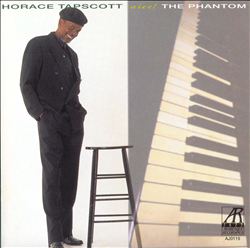






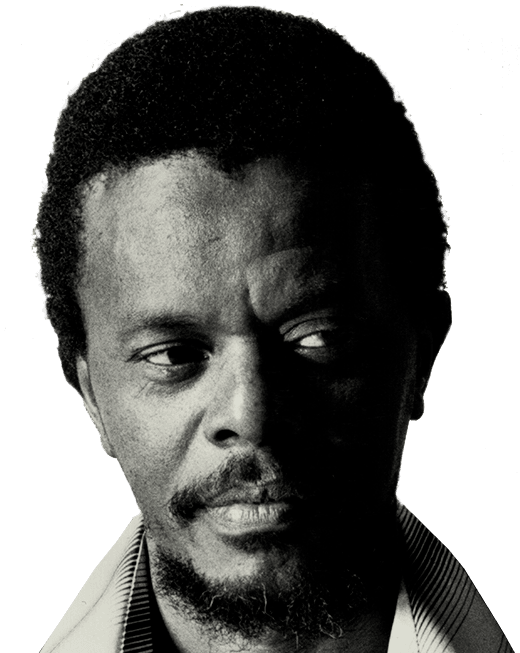
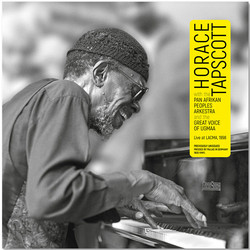
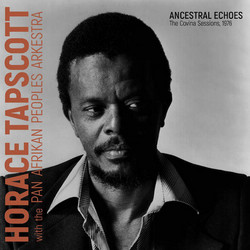
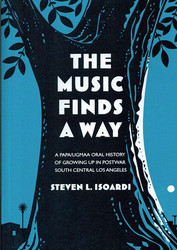
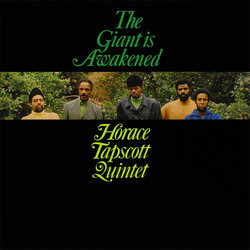
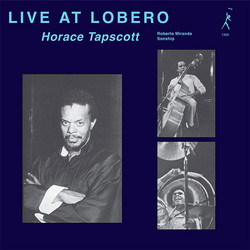
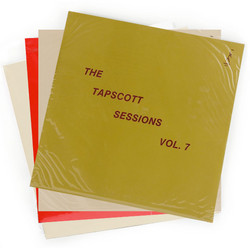
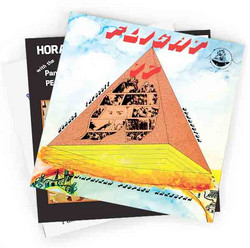
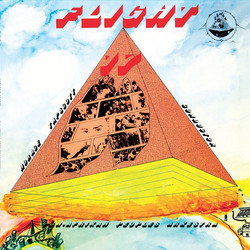
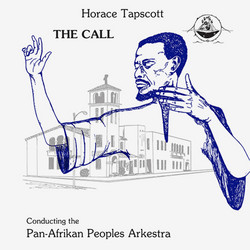
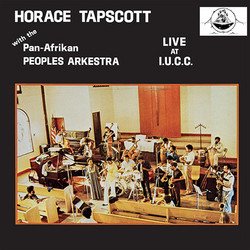
9(MDAyMTYxODUxMDEyOTc4NzE4ODNmNjI3Yg004))
